
THE GREATEST PLAYER EVER!!!! ALFREDO DI STEFANO ALFREDO DI STEFANO Di Stéfano was now an official player of Real Madrid. The very next day he played in a Spanish league in a 5-0 victory. The opponents was none other than Barcelona. The Catalan club was on the receiving end of Alfredo's awe-inspiring magic. This match is remembered in Spain to this day. If you don't think Barcelona regretted enough, FOUR of the goals were scored by Di Stéfano himself. Paco Gento also played in that match, Gento was a young left winger. President Bernabeu signed him the same year Di Stéfano joined Real. Gento and Di Stéfano formed the backbone of a great team that conquered Spain, and later Europe. Inspired by Gento, Hector Rial and, above all, Di Stefano, Real Madrid won the 1953/54 Championship. Di Stefano had now replaced Barcelona's Kubala as the number one player in Spain. The next season was the first season of the European Cup. As Spanish champions, Real Madrid qualified for the first ever European Cup. This is where the real legend of Alfredo Di Stefano started.  The 1956/57 season is the first season the European Cup was launched. This tournament was small and Real beat Servette, Partizan Belgrade and AC Milan to reach the Final. Their opponents were a formidable Reims side led by Raymond Kopa, considered the greatest French player until the arrival of Michel Platini. In a difficult match, Real fell behind twice but Di Stéfano led a great comeback and Real won the first European Cup. 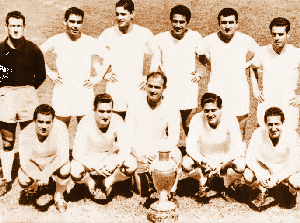 After the first European Cup Final, Real were so impressed by Kopa that they bought him from Reims. But with Di Stéfano playing as the "deep-lying center-forward", Kopa was forced to play on the right wing. With a forward line now comprising of Di Stéfano, Rial, Kopa and Gento, Real retained the trophy. Their semi-final opponents were Manchester United and the so-called "Busby Babes", including Bobby Charlton and Duncan Edwards. In the Final, Di Stéfano scored one of the goals, blasting in a penalty to defeat Fiorentina 2-0.  This year, Real Madrid also won the domestic championship and Di Stéfano was top scorer in both the Spanish league and the Champion's Cup. Following his outstanding season, Di Stéfano was voted European Footballer of the Year. He was also named the Spanish player of the Year. 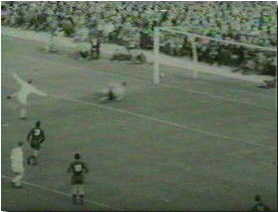 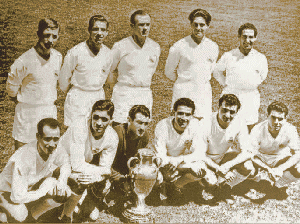 In 1957/58 season, following the acquisition of Kopa from France, Real Madrid brought another superstar from overseas. He was the famous Uruguayan center-back Jose Santamaria, who starred in the 1954 World Cup in Switzerland. This season Alfredo played even more spectacularly, he can be found dashing between the two penalty areas, making clearances on the defensive, making plays in midfield and scoring goals in attack. Their opponents in the Final was Milan, who they defeated in the 1956 semis. Milan's lineup included two World Cup superstars - Sweden's Liedholm and Schiaffino of Uruguay, plus Italy's Cesare Maldini. Together, they gave Real a run for their money. But again Di Stéfano rose to the occasion, scoring one goal and inspiring them to a 3-2 victory after extra-time. 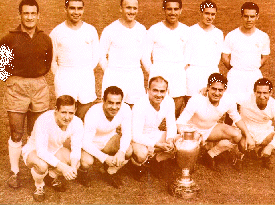 This season, 1958/59, Real again looked for new players to strengthen there already-impressive squad. They bought Didi from Brazil (Pele of that time period) and also signed Puskas.  Didi, who played in the same orchestrator role as Di Stéfano, lack the fitness and stamina for the Spanish game and did not fit in with the team. But Puskas shone by scoring 30 goals in the league, even though he did not play in the 1959 European Cup Final. In Europe, Di Stefano led Real to the 4th Champion's Cup, beating Just Fontaine's Reims. In the domestic front, Di Stéfano won the Spanish league top scorer award for the fourth consecutive time. 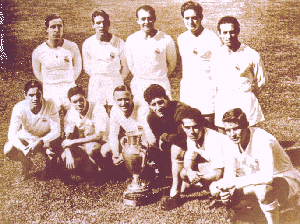 In 1959/60 Expectations were again sky-high for Real in the European Cup, especially when Real were "only" second in the domestic league and Spanish Cup. Many people said before the match Real Madrid dominance will come to an end. Einchrant Frankfurt, afterall, have beaten Scottish champions Glasglow Rangers 12-4. How will Di Stéfano respond to his dangerous opponent? Eintracht Frankfurt started the game well and went ahead in the 18th minute. With Real playing below their standard at this point, Di Stefano suddenly shifted up a gear and took control of the game. In the 27th minute, he ran into the Eintracht penalty area for the first time and immediately scored an equalising goal. Di Stefano's opening goal meant he scored in all 5 Champions' Cup Finals he played in.  A few minutes later, Canario hit a shot which Eintracht goalkeeper fumbled. Di Stefano, even in his mid 30s, was the fastest man to react. He raced in and blasted the ball into the roof of the net. With Alfredo dominating the pitch, Real controlled the game and Puskas scored 4 goals including one penalty. The Germans then scored to make it 6-2. Right from the restart, Di Stéfano received the ball from Gento in the center circle. He brushed aside one opponent, and then played a one-two with a teammate to get past two defenders. Darting right towards the penalty area, nobody can catch him and the striker unleashed a powerful shot from the edge of the area. The ball flew into the bottom left hand corner with the Eintracht goalkeeper stranded. The match, which ended 7-3, was still being revered as the greatest game ever played. 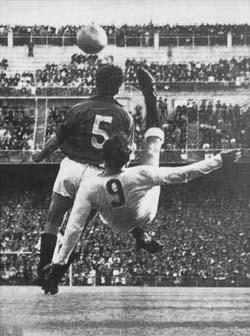 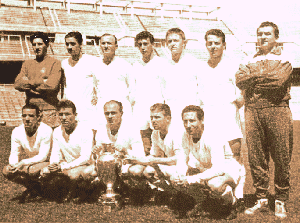 By many considered the best club side ever In the autumn of 1960, the first ever World Cup club was launched. As the champion of Europe, Real played a two-leg tie against the South American champion to decide who will take the world title. Their opponents was Penarol of Uruguay. After a long trip to Uruguay, Real Madrid only drew 0-0. But in the return leg played in Madrid, Di Stefano and Puskas both hit form again. Real stormed to a crushing 5-1 victory, with Di Stefano scoring one of the goals. Real thus won the first ever Intercontinental Cup and Di Stefano was now a world champion. On November 23, 1960, Di Stéfano and his Real Madrid teammates suffer their first ever defeat in a European Cup tie. Real had 3 goals disallowed and hit the woodwork twice. This defeat turned to be the turning point of Di Stefano's European adventure. And Real Madrid would never be the same. Benfica was Real Madrid's opponent in the 1962 European Cup Final Real Madrid would reach 2 more European Cup Finals under Alfredo's guidance. The 1962 defeat by Eusebio's Benfica showed the importance of Di Stefano to the Madrid team. In the first half, Di Stéfano lied deep and controlled the game for Real. He also provided one of the most stunning through passes for Puskas to complete his hat-trick. For all the talents of Puskas and Gento, Benfica manager Guttmann knew who the real danger man was and sent Cavem to mark Alfredo in the second-half. With Di Stéfano heavily marked, Real struggled to build their attacks and Benfica now completely dominated the game. They scored 3 second half goals and won the match 5-3, and thus the 1962 European Cup. 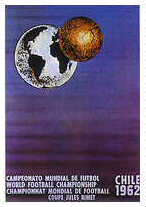 The 1962 World Cup in Chile, was Alfredo's last chance. Perhaps the greatest regret in Di Stefano's career up to this point was not having played in the World Cup finals. He had his last chance in 1962, when Spain qualified for the tournament. Although a bit past his best at 36, Di Stefano was still the driving force that took Madrid to the European Cup Final a few months ago. He have also broken the goal-scoring record of the Spanish national team. Coach Helenio Herrera still selected him for the squad. However, luck was not on his side when he suffered an injury prior to the tournament. However, Di Stefano did not managed to recover and did not play in any of the games. A star-studded Spanish team, packed with international stars Puskas, Suarez, Gento, Del Sol and Santamaria, showed how important Di Stéfano was when they crashed out of the tournament after the first round< BR>  When the next European Cup Final came around, Di Stefano was already 38. And with Alfredo going older everyday, Real's bid to return to glory became more and more difficult. Di Stefano, was now criticized as being slow. Alfredo perhaps tried too hard to justify himself to the media and ended up having an unhappy time. In 1964, Real Madrid again reached the European Cup Final but was defeated 3-1 by Italy's Inter and their catenaccio tactics. The match proved to be Di Stéfano's last major game for Real. He then moved to Espanyol of Barcelona, scoring 19 goals in next two seasons. 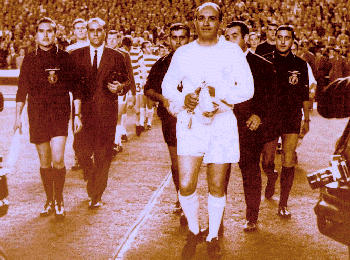 In 1966, a back injury finally forced the Argentine-born maestro to retire at the age of 40. A tearful Alfredo played his farewell match against Scottish side Celtic in the Charmatin, Real Madrid's stadium, later to be known as the Santiago Bernabeu Stadium. 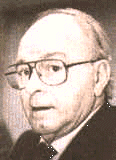 After a long and successful 32-year playing career, Di Stefano took up coaching, He was the boss of Boca Juniors. Returning to Europe, he coached Portugal's Sporting Lisbon for part of their 1974-75 season. Later, he returned to his old club River Plate and won the Argentine championship.  He moved back to Spain soon afterwards and coached Valencia to the Spanish championship and then the Cup Winner's Cup. He also managed Real Madrid in two short spells during the 1982-1983 and 1990-1991 seasons. 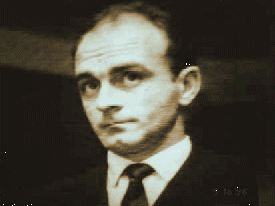 As a player Alfredo won 13 national championships, 1 domestic cup, 8 league top-scorer awards, 5 national Athlete of the Year award, 1 World Club Cup, 5 Champions' Cups, 1 South American Championship, 2 international club tournaments, 2 international club competition topscorer award, 2 European Footballer awards, 1 All-time European Player award. As a coach he won 2 national championships and 1 Cup Winner's Cup |
| INFORMATION |
| Copyrighted © since 1998 [email protected] |
|